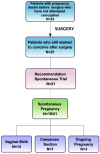Superficial Peritoneal Endometriosis Vaporization Using a CO2 Laser: A Long-Term Single-Center Experience
- PMID: 38541947
- PMCID: PMC10971539
- DOI: 10.3390/jcm13061722
Superficial Peritoneal Endometriosis Vaporization Using a CO2 Laser: A Long-Term Single-Center Experience
Abstract
Background: The validation of laser usage during laparoscopic procedures, notably by Camran Nezhat in the late 1980s, has been significant. Lasers offer precision and depth control in tissue vaporization without bleeding. Surgical intervention remains central in managing endometriosis-associated pain and infertility, especially for patients unresponsive to hormonal therapy. Methods: This retrospective cohort study included 200 patients with superficial peritoneal endometriosis (SPE) who underwent laparoscopic laser vaporization. Surgery was performed using a CO2 laser, and histological confirmation of endometriosis was obtained for all cases. Pain scores and SF-36 questionnaire domains were assessed preoperatively and postoperatively. Fertility outcomes were evaluated among patients desiring pregnancy. Results: Significant improvements in pain score and SF-36 questionnaire domains were observed postoperatively (p-value < 0.01), indicating enhanced quality of life. Among infertile patients with an active desire for pregnancy, surgical treatment showed an overall pregnancy rate after surgery of 93.7% (p-value < 0.01), including 75.7% natural pregnancies and 24.3% IVF. Laser vaporization enabled precise lesion removal with minimal tissue damage, short operative time, and minimal blood loss. Conclusions: Laparoscopic laser vaporization is an effective treatment for SPE, offering pain relief, improved quality of life, and favorable fertility outcomes. Further research is needed to validate these results in terms of pain control and fertility.
Keywords: CO2 laser; endometriosis; fertility; pain; superficial peritoneal endometriosis.
Conflict of interest statement
Luca Giannoni was employed by the company Elen. The remaining authors declare that the research was conducted in the absence of any commercial or financial relationships that could be construed as a potential conflict of interest.
Figures





Similar articles
-
Assessment of ovarian reserve after cystectomy versus 'one-step' laser vaporization in the treatment of ovarian endometrioma: a small randomized clinical trial.Hum Reprod. 2018 Dec 1;33(12):2205-2211. doi: 10.1093/humrep/dey305. Hum Reprod. 2018. PMID: 30299482 Free PMC article. Clinical Trial.
-
Prophylactic procedures associated with gynecological surgery for the management of superficial endometriosis and adhesions. Clinical practice guidelines from the French College of Gynecologists and Obstetricians (CNGOF)✰.J Gynecol Obstet Hum Reprod. 2021 Dec;50(10):102206. doi: 10.1016/j.jogoh.2021.102206. Epub 2021 Aug 12. J Gynecol Obstet Hum Reprod. 2021. PMID: 34391952
-
Efficacy of isotopic 13CO2 laser laparoscopic evaporation in the treatment of infertile patients with minimal and mild endometriosis: a life table cumulative pregnancy rates study.J Am Assoc Gynecol Laparosc. 1997 Feb;4(2):219-23. doi: 10.1016/s1074-3804(97)80013-8. J Am Assoc Gynecol Laparosc. 1997. PMID: 9050731 Clinical Trial.
-
Impact on ovarian reserve and fertility using carbon dioxide laser for endometriosis treatment: a systematic review.Gynecol Endocrinol. 2022 Aug;38(8):617-622. doi: 10.1080/09513590.2022.2087218. Epub 2022 Jul 13. Gynecol Endocrinol. 2022. PMID: 35822466
-
[Endometriosis: indications, operative techniques, results].Rev Prat. 1991 Dec 1;41(25):2563-6. Rev Prat. 1991. PMID: 1839457 Review. French.
Cited by
-
Applicability of ultrasound-guided puncture and laparoscopic cystectomy for ovarian endometriosis cyst: a non-randomized trial.Eur J Med Res. 2025 Apr 30;30(1):348. doi: 10.1186/s40001-025-02612-5. Eur J Med Res. 2025. PMID: 40307955 Free PMC article.
-
A Systematic Review of Ureteral Reimplantation Techniques in Endometriosis: Laparoscopic Versus Robotic-Assisted Approach.J Clin Med. 2024 Sep 24;13(19):5677. doi: 10.3390/jcm13195677. J Clin Med. 2024. PMID: 39407736 Free PMC article. Review.
-
Ultrasound Assessment in Polycystic Ovary Syndrome Diagnosis: From Origins to Future Perspectives-A Comprehensive Review.Biomedicines. 2025 Feb 12;13(2):453. doi: 10.3390/biomedicines13020453. Biomedicines. 2025. PMID: 40002866 Free PMC article. Review.
-
Fluorescence-guided ureteral identification in robotic surgery for advanced endometriosis: a comparison of junior versus senior surgeons.Sci Rep. 2025 Jun 6;15(1):19933. doi: 10.1038/s41598-025-05082-1. Sci Rep. 2025. PMID: 40481106 Free PMC article.
-
Sustained Metabolic Improvements with Low-Dose Metformin Combined with Oral Contraceptives in Female Adolescents with PCOS: A Single-Center Retrospective Cohort Study.Adv Ther. 2025 Aug;42(8):3762-3773. doi: 10.1007/s12325-025-03251-2. Epub 2025 Jun 6. Adv Ther. 2025. PMID: 40478377 Free PMC article.
References
-
- Rahmioglu N., Mortlock S., Ghiasi M., Møller P.L., Stefansdottir L., Galarneau G., Turman C., Danning R., Law M.H., Sapkota Y., et al. The Genetic Basis of Endometriosis and Comorbidity with Other Pain and Inflammatory Conditions. Nat. Genet. 2023;55:423–436. doi: 10.1038/s41588-023-01323-z. - DOI - PMC - PubMed
-
- Rogers P.A.W., D’Hooghe T.M., Fazleabas A., Gargett C.E., Giudice L.C., Montgomery G.W., Rombauts L., Salamonsen L.A., Zondervan K.T. Priorities for Endometriosis Research: Recommendations from an International Consensus Workshop. Reprod. Sci. 2009;16:335–346. doi: 10.1177/1933719108330568. - DOI - PMC - PubMed
LinkOut - more resources
Full Text Sources

